Plant and Equipment Asset Management Plan: Council Overview
VerifiedAdded on 2023/01/16
|26
|5635
|42
Report
AI Summary
This Plant and Equipment Asset Management Plan provides an executive summary of the council's asset management strategies. The council manages a fleet of plant, trucks, trailers, business vehicles, and furniture, with a total asset value of $3,316,000. The plan outlines a ten-year projection for operations, maintenance, renewals, and upgrades, totaling $4,549,000 annually. The plan addresses service levels, future demand, lifecycle management, and financial outlines, and includes details on customer expectations, legislative requirements, and current service levels. Key components of the plan include levels of service, future demand, lifecycle management, financial outline, asset management practices, and monitoring. The plan also discusses risks, such as deficient resources and incomplete asset knowledge, and proposes strategies to mitigate these risks, including condition assessments and monitoring of maintenance trends. It also addresses legislative needs, demand management, and lifecycle management, providing a framework for sustainable service delivery and financial planning. The document also details the current asset values, depreciation, and renewal rates.
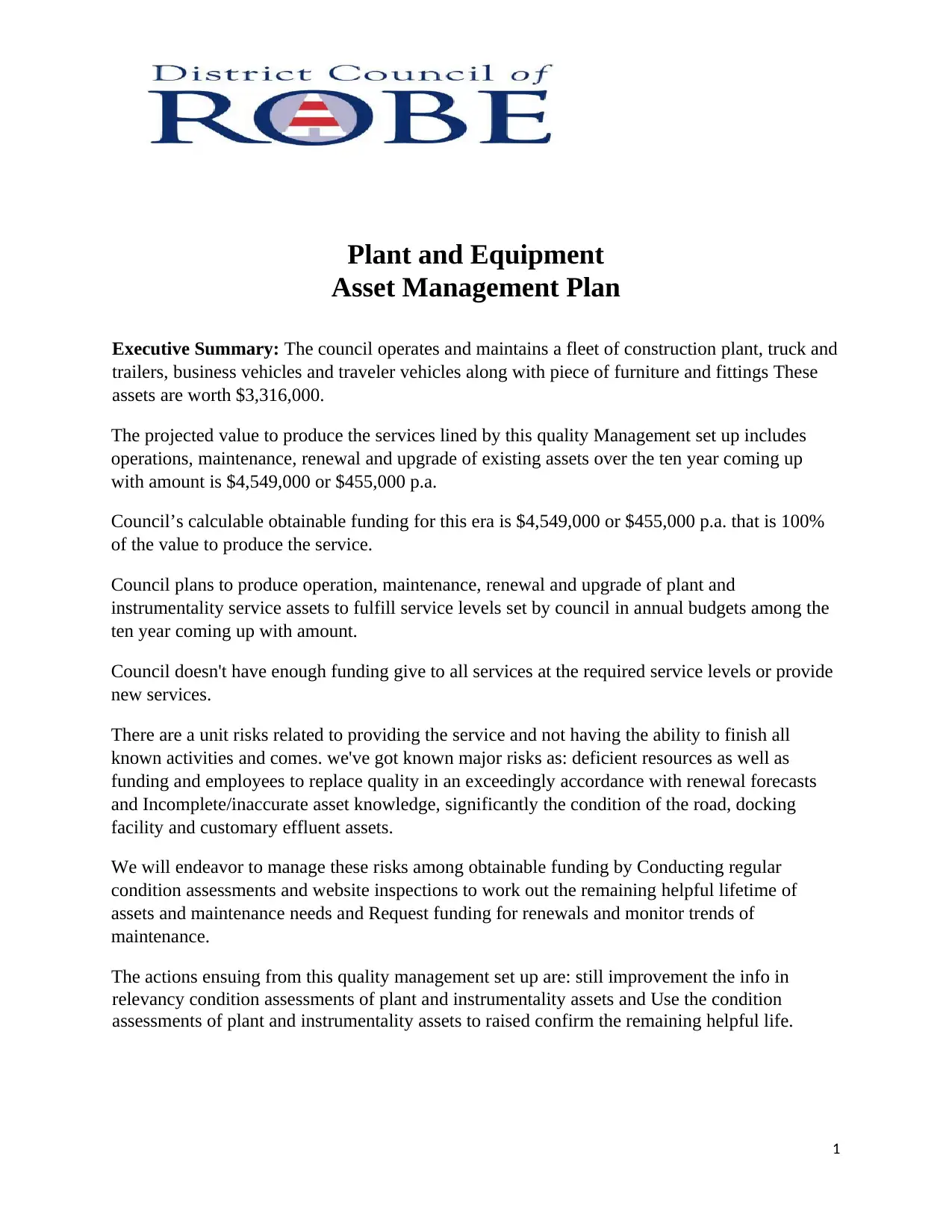
Plant and Equipment
Asset Management Plan
Executive Summary: The council operates and maintains a fleet of construction plant, truck and
trailers, business vehicles and traveler vehicles along with piece of furniture and fittings These
assets are worth $3,316,000.
The projected value to produce the services lined by this quality Management set up includes
operations, maintenance, renewal and upgrade of existing assets over the ten year coming up
with amount is $4,549,000 or $455,000 p.a.
Council’s calculable obtainable funding for this era is $4,549,000 or $455,000 p.a. that is 100%
of the value to produce the service.
Council plans to produce operation, maintenance, renewal and upgrade of plant and
instrumentality service assets to fulfill service levels set by council in annual budgets among the
ten year coming up with amount.
Council doesn't have enough funding give to all services at the required service levels or provide
new services.
There are a unit risks related to providing the service and not having the ability to finish all
known activities and comes. we've got known major risks as: deficient resources as well as
funding and employees to replace quality in an exceedingly accordance with renewal forecasts
and Incomplete/inaccurate asset knowledge, significantly the condition of the road, docking
facility and customary effluent assets.
We will endeavor to manage these risks among obtainable funding by Conducting regular
condition assessments and website inspections to work out the remaining helpful lifetime of
assets and maintenance needs and Request funding for renewals and monitor trends of
maintenance.
The actions ensuing from this quality management set up are: still improvement the info in
relevancy condition assessments of plant and instrumentality assets and Use the condition
assessments of plant and instrumentality assets to raised confirm the remaining helpful life.
1
Asset Management Plan
Executive Summary: The council operates and maintains a fleet of construction plant, truck and
trailers, business vehicles and traveler vehicles along with piece of furniture and fittings These
assets are worth $3,316,000.
The projected value to produce the services lined by this quality Management set up includes
operations, maintenance, renewal and upgrade of existing assets over the ten year coming up
with amount is $4,549,000 or $455,000 p.a.
Council’s calculable obtainable funding for this era is $4,549,000 or $455,000 p.a. that is 100%
of the value to produce the service.
Council plans to produce operation, maintenance, renewal and upgrade of plant and
instrumentality service assets to fulfill service levels set by council in annual budgets among the
ten year coming up with amount.
Council doesn't have enough funding give to all services at the required service levels or provide
new services.
There are a unit risks related to providing the service and not having the ability to finish all
known activities and comes. we've got known major risks as: deficient resources as well as
funding and employees to replace quality in an exceedingly accordance with renewal forecasts
and Incomplete/inaccurate asset knowledge, significantly the condition of the road, docking
facility and customary effluent assets.
We will endeavor to manage these risks among obtainable funding by Conducting regular
condition assessments and website inspections to work out the remaining helpful lifetime of
assets and maintenance needs and Request funding for renewals and monitor trends of
maintenance.
The actions ensuing from this quality management set up are: still improvement the info in
relevancy condition assessments of plant and instrumentality assets and Use the condition
assessments of plant and instrumentality assets to raised confirm the remaining helpful life.
1
Paraphrase This Document
Need a fresh take? Get an instant paraphrase of this document with our AI Paraphraser
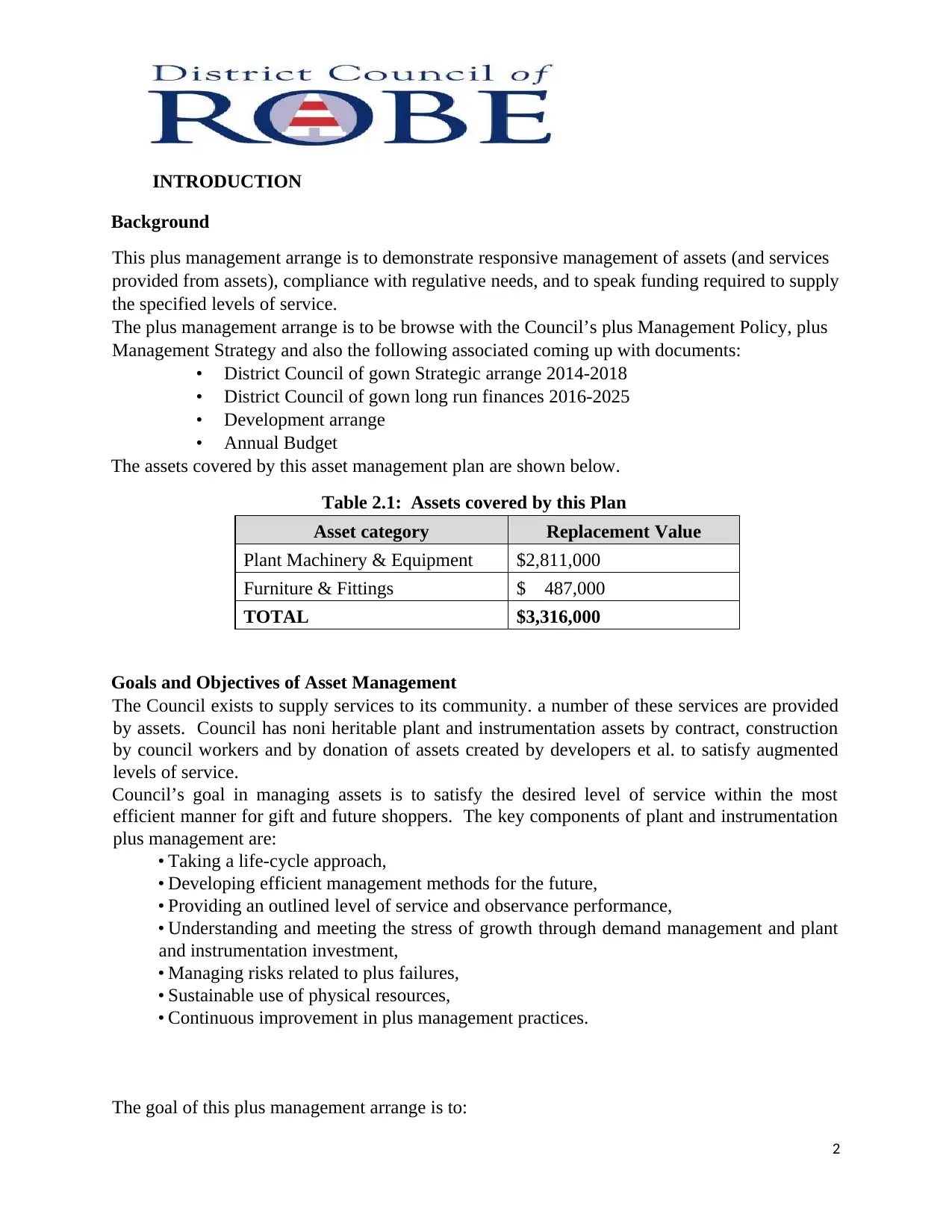
INTRODUCTION
Background
This plus management arrange is to demonstrate responsive management of assets (and services
provided from assets), compliance with regulative needs, and to speak funding required to supply
the specified levels of service.
The plus management arrange is to be browse with the Council’s plus Management Policy, plus
Management Strategy and also the following associated coming up with documents:
• District Council of gown Strategic arrange 2014-2018
• District Council of gown long run finances 2016-2025
• Development arrange
• Annual Budget
The assets covered by this asset management plan are shown below.
Table 2.1: Assets covered by this Plan
Asset category Replacement Value
Plant Machinery & Equipment $2,811,000
Furniture & Fittings $ 487,000
TOTAL $3,316,000
Goals and Objectives of Asset Management
The Council exists to supply services to its community. a number of these services are provided
by assets. Council has noni heritable plant and instrumentation assets by contract, construction
by council workers and by donation of assets created by developers et al. to satisfy augmented
levels of service.
Council’s goal in managing assets is to satisfy the desired level of service within the most
efficient manner for gift and future shoppers. The key components of plant and instrumentation
plus management are:
• Taking a life-cycle approach,
• Developing efficient management methods for the future,
• Providing an outlined level of service and observance performance,
• Understanding and meeting the stress of growth through demand management and plant
and instrumentation investment,
• Managing risks related to plus failures,
• Sustainable use of physical resources,
• Continuous improvement in plus management practices.
The goal of this plus management arrange is to:
2
Background
This plus management arrange is to demonstrate responsive management of assets (and services
provided from assets), compliance with regulative needs, and to speak funding required to supply
the specified levels of service.
The plus management arrange is to be browse with the Council’s plus Management Policy, plus
Management Strategy and also the following associated coming up with documents:
• District Council of gown Strategic arrange 2014-2018
• District Council of gown long run finances 2016-2025
• Development arrange
• Annual Budget
The assets covered by this asset management plan are shown below.
Table 2.1: Assets covered by this Plan
Asset category Replacement Value
Plant Machinery & Equipment $2,811,000
Furniture & Fittings $ 487,000
TOTAL $3,316,000
Goals and Objectives of Asset Management
The Council exists to supply services to its community. a number of these services are provided
by assets. Council has noni heritable plant and instrumentation assets by contract, construction
by council workers and by donation of assets created by developers et al. to satisfy augmented
levels of service.
Council’s goal in managing assets is to satisfy the desired level of service within the most
efficient manner for gift and future shoppers. The key components of plant and instrumentation
plus management are:
• Taking a life-cycle approach,
• Developing efficient management methods for the future,
• Providing an outlined level of service and observance performance,
• Understanding and meeting the stress of growth through demand management and plant
and instrumentation investment,
• Managing risks related to plus failures,
• Sustainable use of physical resources,
• Continuous improvement in plus management practices.
The goal of this plus management arrange is to:
2
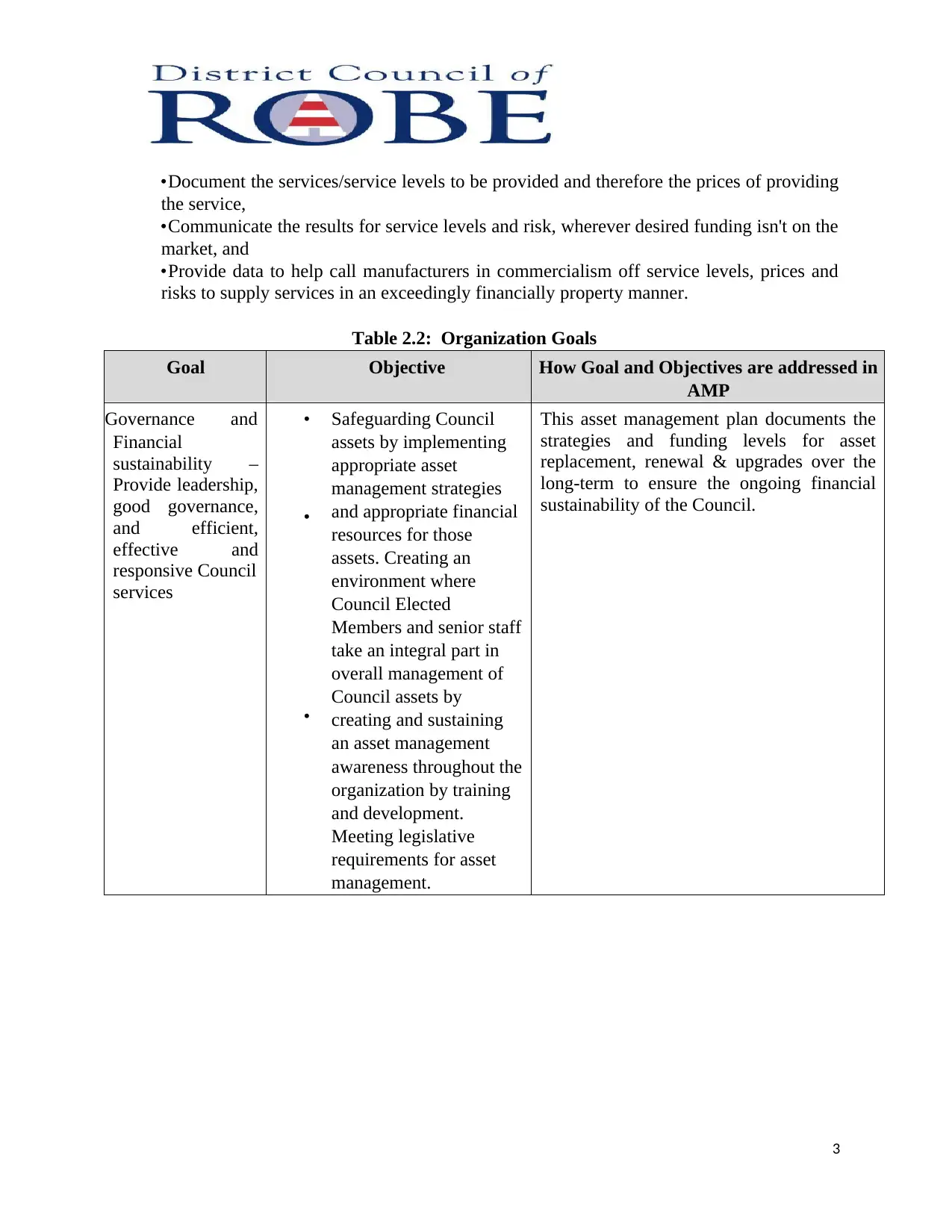
•Document the services/service levels to be provided and therefore the prices of providing
the service,
•Communicate the results for service levels and risk, wherever desired funding isn't on the
market, and
•Provide data to help call manufacturers in commercialism off service levels, prices and
risks to supply services in an exceedingly financially property manner.
Table 2.2: Organization Goals
Goal Objective How Goal and Objectives are addressed in
AMP
Governance and
Financial
sustainability –
Provide leadership,
good governance,
and efficient,
effective and
responsive Council
services
•
•
•
Safeguarding Council
assets by implementing
appropriate asset
management strategies
and appropriate financial
resources for those
assets. Creating an
environment where
Council Elected
Members and senior staff
take an integral part in
overall management of
Council assets by
creating and sustaining
an asset management
awareness throughout the
organization by training
and development.
Meeting legislative
requirements for asset
management.
This asset management plan documents the
strategies and funding levels for asset
replacement, renewal & upgrades over the
long-term to ensure the ongoing financial
sustainability of the Council.
3
the service,
•Communicate the results for service levels and risk, wherever desired funding isn't on the
market, and
•Provide data to help call manufacturers in commercialism off service levels, prices and
risks to supply services in an exceedingly financially property manner.
Table 2.2: Organization Goals
Goal Objective How Goal and Objectives are addressed in
AMP
Governance and
Financial
sustainability –
Provide leadership,
good governance,
and efficient,
effective and
responsive Council
services
•
•
•
Safeguarding Council
assets by implementing
appropriate asset
management strategies
and appropriate financial
resources for those
assets. Creating an
environment where
Council Elected
Members and senior staff
take an integral part in
overall management of
Council assets by
creating and sustaining
an asset management
awareness throughout the
organization by training
and development.
Meeting legislative
requirements for asset
management.
This asset management plan documents the
strategies and funding levels for asset
replacement, renewal & upgrades over the
long-term to ensure the ongoing financial
sustainability of the Council.
3
⊘ This is a preview!⊘
Do you want full access?
Subscribe today to unlock all pages.

Trusted by 1+ million students worldwide
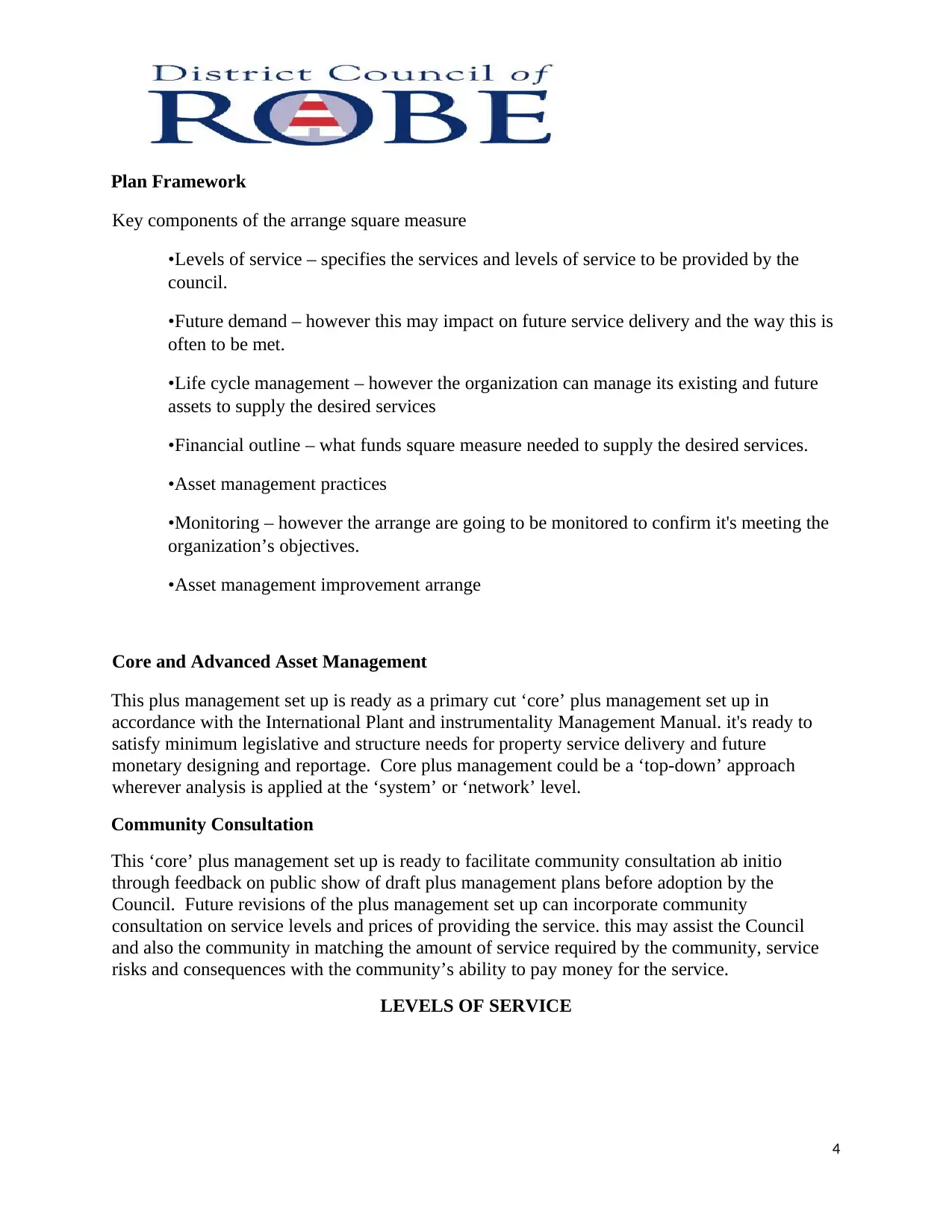
Plan Framework
Key components of the arrange square measure
•Levels of service – specifies the services and levels of service to be provided by the
council.
•Future demand – however this may impact on future service delivery and the way this is
often to be met.
•Life cycle management – however the organization can manage its existing and future
assets to supply the desired services
•Financial outline – what funds square measure needed to supply the desired services.
•Asset management practices
•Monitoring – however the arrange are going to be monitored to confirm it's meeting the
organization’s objectives.
•Asset management improvement arrange
Core and Advanced Asset Management
This plus management set up is ready as a primary cut ‘core’ plus management set up in
accordance with the International Plant and instrumentality Management Manual. it's ready to
satisfy minimum legislative and structure needs for property service delivery and future
monetary designing and reportage. Core plus management could be a ‘top-down’ approach
wherever analysis is applied at the ‘system’ or ‘network’ level.
Community Consultation
This ‘core’ plus management set up is ready to facilitate community consultation ab initio
through feedback on public show of draft plus management plans before adoption by the
Council. Future revisions of the plus management set up can incorporate community
consultation on service levels and prices of providing the service. this may assist the Council
and also the community in matching the amount of service required by the community, service
risks and consequences with the community’s ability to pay money for the service.
LEVELS OF SERVICE
4
Key components of the arrange square measure
•Levels of service – specifies the services and levels of service to be provided by the
council.
•Future demand – however this may impact on future service delivery and the way this is
often to be met.
•Life cycle management – however the organization can manage its existing and future
assets to supply the desired services
•Financial outline – what funds square measure needed to supply the desired services.
•Asset management practices
•Monitoring – however the arrange are going to be monitored to confirm it's meeting the
organization’s objectives.
•Asset management improvement arrange
Core and Advanced Asset Management
This plus management set up is ready as a primary cut ‘core’ plus management set up in
accordance with the International Plant and instrumentality Management Manual. it's ready to
satisfy minimum legislative and structure needs for property service delivery and future
monetary designing and reportage. Core plus management could be a ‘top-down’ approach
wherever analysis is applied at the ‘system’ or ‘network’ level.
Community Consultation
This ‘core’ plus management set up is ready to facilitate community consultation ab initio
through feedback on public show of draft plus management plans before adoption by the
Council. Future revisions of the plus management set up can incorporate community
consultation on service levels and prices of providing the service. this may assist the Council
and also the community in matching the amount of service required by the community, service
risks and consequences with the community’s ability to pay money for the service.
LEVELS OF SERVICE
4
Paraphrase This Document
Need a fresh take? Get an instant paraphrase of this document with our AI Paraphraser
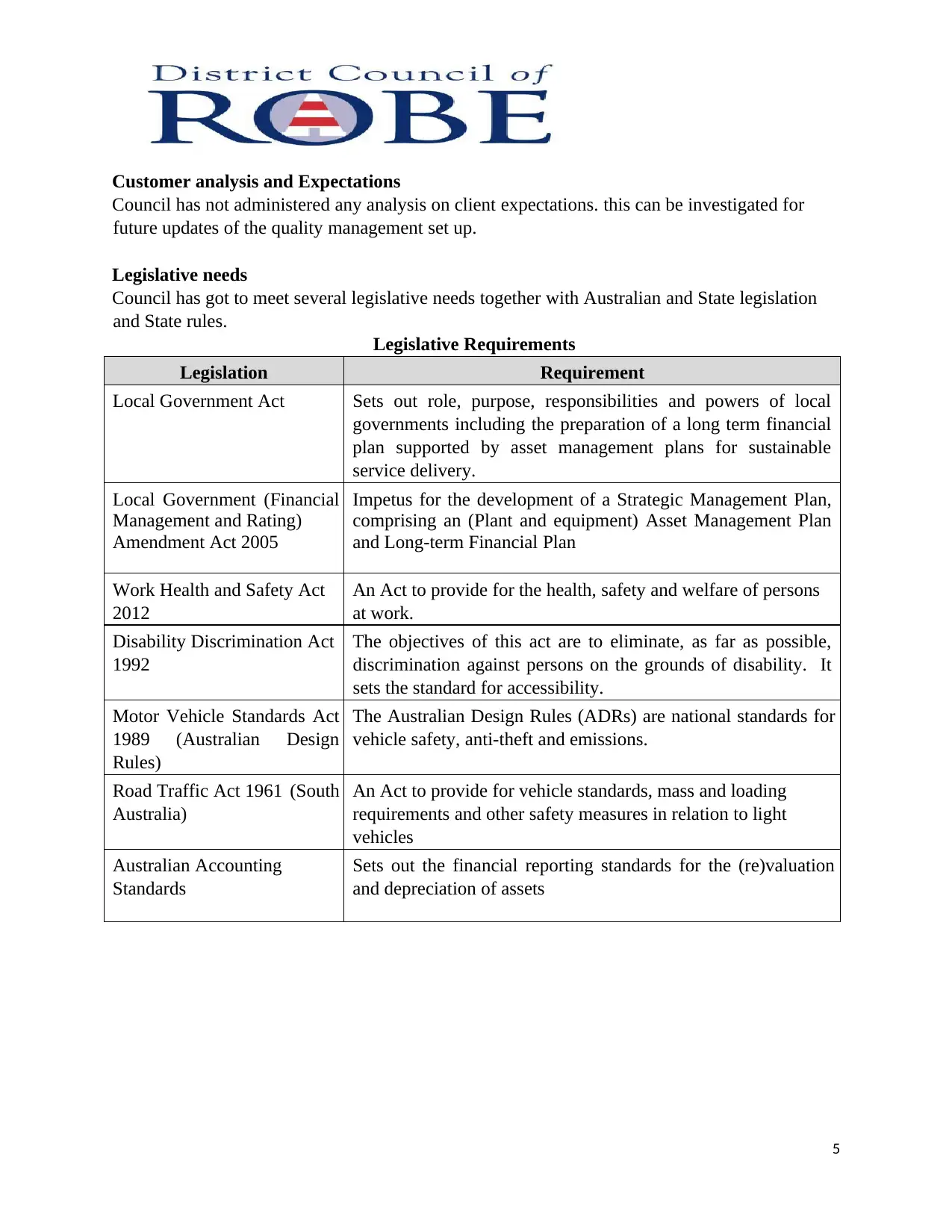
Customer analysis and Expectations
Council has not administered any analysis on client expectations. this can be investigated for
future updates of the quality management set up.
Legislative needs
Council has got to meet several legislative needs together with Australian and State legislation
and State rules.
Legislative Requirements
Legislation Requirement
Local Government Act Sets out role, purpose, responsibilities and powers of local
governments including the preparation of a long term financial
plan supported by asset management plans for sustainable
service delivery.
Local Government (Financial
Management and Rating)
Amendment Act 2005
Impetus for the development of a Strategic Management Plan,
comprising an (Plant and equipment) Asset Management Plan
and Long-term Financial Plan
Work Health and Safety Act
2012
An Act to provide for the health, safety and welfare of persons
at work.
Disability Discrimination Act
1992
The objectives of this act are to eliminate, as far as possible,
discrimination against persons on the grounds of disability. It
sets the standard for accessibility.
Motor Vehicle Standards Act
1989 (Australian Design
Rules)
The Australian Design Rules (ADRs) are national standards for
vehicle safety, anti-theft and emissions.
Road Traffic Act 1961 (South
Australia)
An Act to provide for vehicle standards, mass and loading
requirements and other safety measures in relation to light
vehicles
Australian Accounting
Standards
Sets out the financial reporting standards for the (re)valuation
and depreciation of assets
5
Council has not administered any analysis on client expectations. this can be investigated for
future updates of the quality management set up.
Legislative needs
Council has got to meet several legislative needs together with Australian and State legislation
and State rules.
Legislative Requirements
Legislation Requirement
Local Government Act Sets out role, purpose, responsibilities and powers of local
governments including the preparation of a long term financial
plan supported by asset management plans for sustainable
service delivery.
Local Government (Financial
Management and Rating)
Amendment Act 2005
Impetus for the development of a Strategic Management Plan,
comprising an (Plant and equipment) Asset Management Plan
and Long-term Financial Plan
Work Health and Safety Act
2012
An Act to provide for the health, safety and welfare of persons
at work.
Disability Discrimination Act
1992
The objectives of this act are to eliminate, as far as possible,
discrimination against persons on the grounds of disability. It
sets the standard for accessibility.
Motor Vehicle Standards Act
1989 (Australian Design
Rules)
The Australian Design Rules (ADRs) are national standards for
vehicle safety, anti-theft and emissions.
Road Traffic Act 1961 (South
Australia)
An Act to provide for vehicle standards, mass and loading
requirements and other safety measures in relation to light
vehicles
Australian Accounting
Standards
Sets out the financial reporting standards for the (re)valuation
and depreciation of assets
5
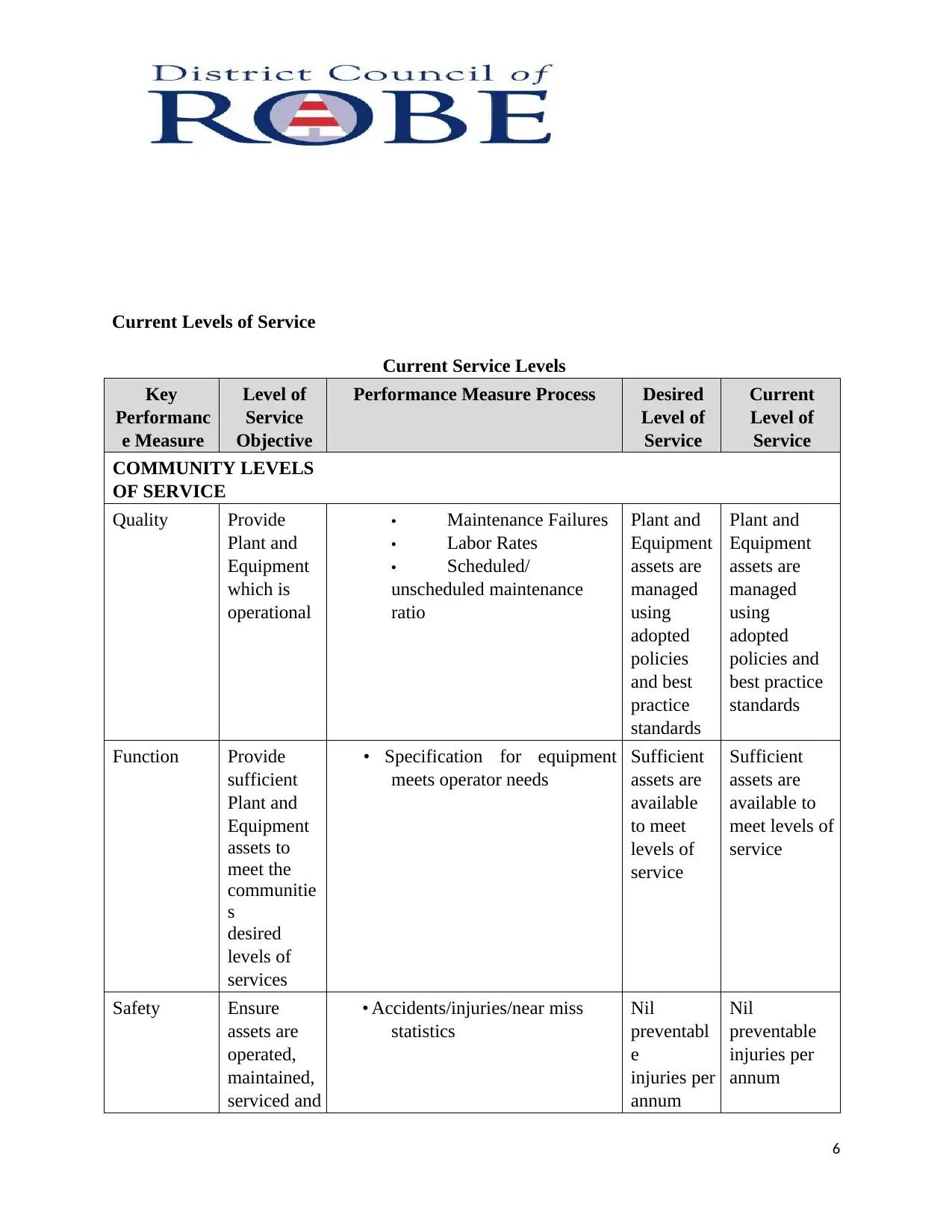
Current Levels of Service
Current Service Levels
Key
Performanc
e Measure
Level of
Service
Objective
Performance Measure Process Desired
Level of
Service
Current
Level of
Service
COMMUNITY LEVELS
OF SERVICE
Quality Provide
Plant and
Equipment
which is
operational
• Maintenance Failures
• Labor Rates
• Scheduled/
unscheduled maintenance
ratio
Plant and
Equipment
assets are
managed
using
adopted
policies
and best
practice
standards
Plant and
Equipment
assets are
managed
using
adopted
policies and
best practice
standards
Function Provide
sufficient
Plant and
Equipment
assets to
meet the
communitie
s
desired
levels of
services
• Specification for equipment
meets operator needs
Sufficient
assets are
available
to meet
levels of
service
Sufficient
assets are
available to
meet levels of
service
Safety Ensure
assets are
operated,
maintained,
serviced and
• Accidents/injuries/near miss
statistics
Nil
preventabl
e
injuries per
annum
Nil
preventable
injuries per
annum
6
Current Service Levels
Key
Performanc
e Measure
Level of
Service
Objective
Performance Measure Process Desired
Level of
Service
Current
Level of
Service
COMMUNITY LEVELS
OF SERVICE
Quality Provide
Plant and
Equipment
which is
operational
• Maintenance Failures
• Labor Rates
• Scheduled/
unscheduled maintenance
ratio
Plant and
Equipment
assets are
managed
using
adopted
policies
and best
practice
standards
Plant and
Equipment
assets are
managed
using
adopted
policies and
best practice
standards
Function Provide
sufficient
Plant and
Equipment
assets to
meet the
communitie
s
desired
levels of
services
• Specification for equipment
meets operator needs
Sufficient
assets are
available
to meet
levels of
service
Sufficient
assets are
available to
meet levels of
service
Safety Ensure
assets are
operated,
maintained,
serviced and
• Accidents/injuries/near miss
statistics
Nil
preventabl
e
injuries per
annum
Nil
preventable
injuries per
annum
6
⊘ This is a preview!⊘
Do you want full access?
Subscribe today to unlock all pages.

Trusted by 1+ million students worldwide
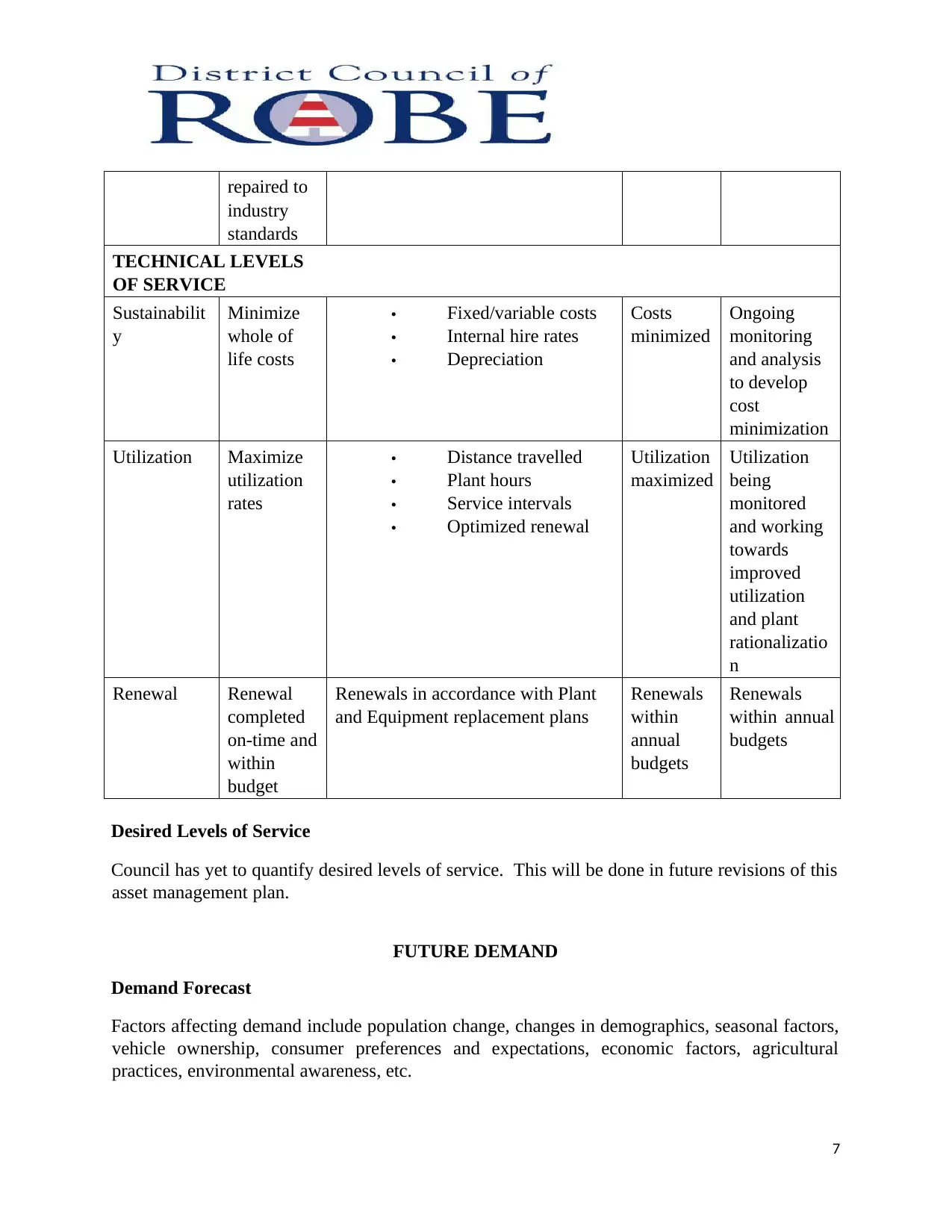
repaired to
industry
standards
TECHNICAL LEVELS
OF SERVICE
Sustainabilit
y
Minimize
whole of
life costs
• Fixed/variable costs
• Internal hire rates
• Depreciation
Costs
minimized
Ongoing
monitoring
and analysis
to develop
cost
minimization
Utilization Maximize
utilization
rates
• Distance travelled
• Plant hours
• Service intervals
• Optimized renewal
Utilization
maximized
Utilization
being
monitored
and working
towards
improved
utilization
and plant
rationalizatio
n
Renewal Renewal
completed
on-time and
within
budget
Renewals in accordance with Plant
and Equipment replacement plans
Renewals
within
annual
budgets
Renewals
within annual
budgets
Desired Levels of Service
Council has yet to quantify desired levels of service. This will be done in future revisions of this
asset management plan.
FUTURE DEMAND
Demand Forecast
Factors affecting demand include population change, changes in demographics, seasonal factors,
vehicle ownership, consumer preferences and expectations, economic factors, agricultural
practices, environmental awareness, etc.
7
industry
standards
TECHNICAL LEVELS
OF SERVICE
Sustainabilit
y
Minimize
whole of
life costs
• Fixed/variable costs
• Internal hire rates
• Depreciation
Costs
minimized
Ongoing
monitoring
and analysis
to develop
cost
minimization
Utilization Maximize
utilization
rates
• Distance travelled
• Plant hours
• Service intervals
• Optimized renewal
Utilization
maximized
Utilization
being
monitored
and working
towards
improved
utilization
and plant
rationalizatio
n
Renewal Renewal
completed
on-time and
within
budget
Renewals in accordance with Plant
and Equipment replacement plans
Renewals
within
annual
budgets
Renewals
within annual
budgets
Desired Levels of Service
Council has yet to quantify desired levels of service. This will be done in future revisions of this
asset management plan.
FUTURE DEMAND
Demand Forecast
Factors affecting demand include population change, changes in demographics, seasonal factors,
vehicle ownership, consumer preferences and expectations, economic factors, agricultural
practices, environmental awareness, etc.
7
Paraphrase This Document
Need a fresh take? Get an instant paraphrase of this document with our AI Paraphraser
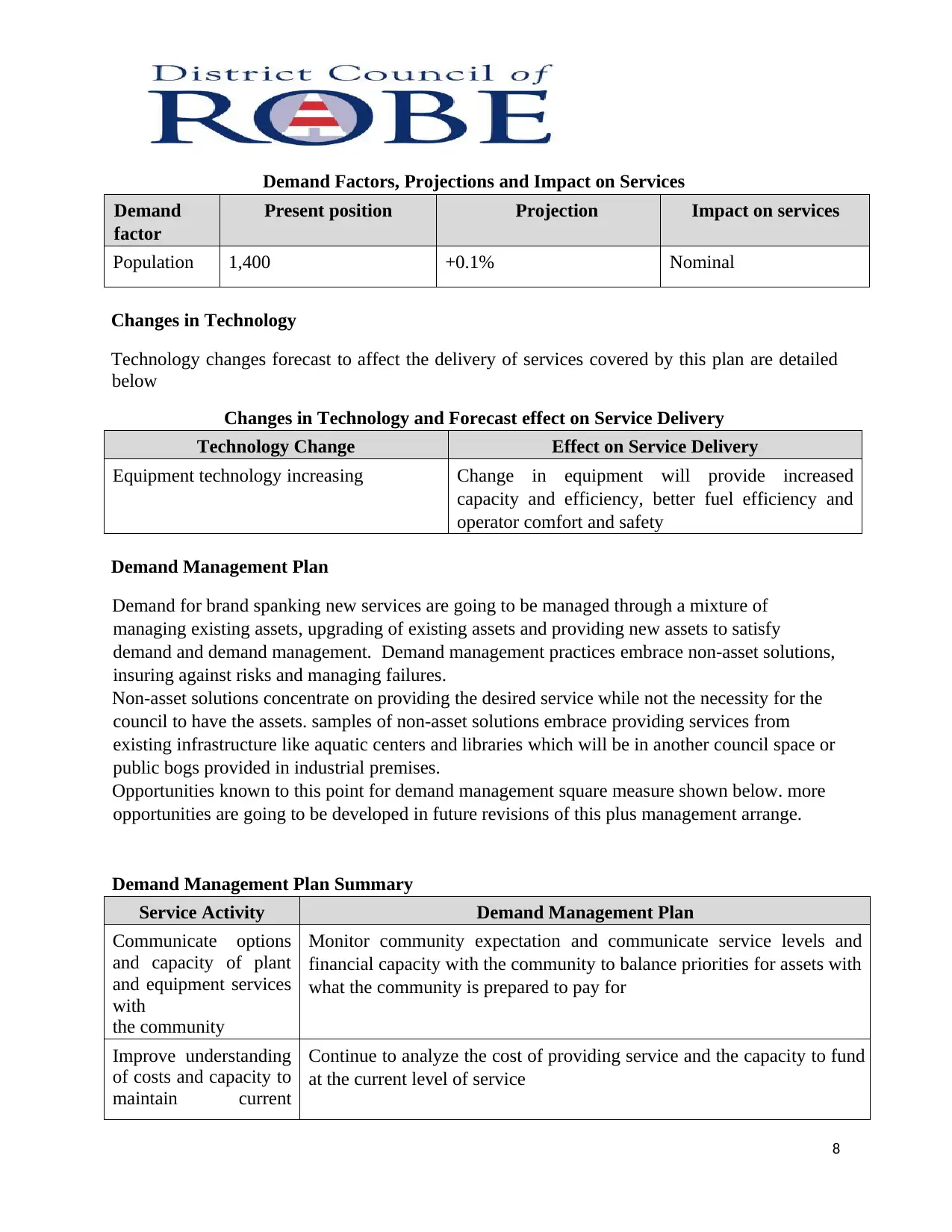
Demand Factors, Projections and Impact on Services
Demand
factor
Present position Projection Impact on services
Population 1,400 +0.1% Nominal
Changes in Technology
Technology changes forecast to affect the delivery of services covered by this plan are detailed
below
Changes in Technology and Forecast effect on Service Delivery
Technology Change Effect on Service Delivery
Equipment technology increasing Change in equipment will provide increased
capacity and efficiency, better fuel efficiency and
operator comfort and safety
Demand Management Plan
Demand for brand spanking new services are going to be managed through a mixture of
managing existing assets, upgrading of existing assets and providing new assets to satisfy
demand and demand management. Demand management practices embrace non-asset solutions,
insuring against risks and managing failures.
Non-asset solutions concentrate on providing the desired service while not the necessity for the
council to have the assets. samples of non-asset solutions embrace providing services from
existing infrastructure like aquatic centers and libraries which will be in another council space or
public bogs provided in industrial premises.
Opportunities known to this point for demand management square measure shown below. more
opportunities are going to be developed in future revisions of this plus management arrange.
Demand Management Plan Summary
Service Activity Demand Management Plan
Communicate options
and capacity of plant
and equipment services
with
the community
Monitor community expectation and communicate service levels and
financial capacity with the community to balance priorities for assets with
what the community is prepared to pay for
Improve understanding
of costs and capacity to
maintain current
Continue to analyze the cost of providing service and the capacity to fund
at the current level of service
8
Demand
factor
Present position Projection Impact on services
Population 1,400 +0.1% Nominal
Changes in Technology
Technology changes forecast to affect the delivery of services covered by this plan are detailed
below
Changes in Technology and Forecast effect on Service Delivery
Technology Change Effect on Service Delivery
Equipment technology increasing Change in equipment will provide increased
capacity and efficiency, better fuel efficiency and
operator comfort and safety
Demand Management Plan
Demand for brand spanking new services are going to be managed through a mixture of
managing existing assets, upgrading of existing assets and providing new assets to satisfy
demand and demand management. Demand management practices embrace non-asset solutions,
insuring against risks and managing failures.
Non-asset solutions concentrate on providing the desired service while not the necessity for the
council to have the assets. samples of non-asset solutions embrace providing services from
existing infrastructure like aquatic centers and libraries which will be in another council space or
public bogs provided in industrial premises.
Opportunities known to this point for demand management square measure shown below. more
opportunities are going to be developed in future revisions of this plus management arrange.
Demand Management Plan Summary
Service Activity Demand Management Plan
Communicate options
and capacity of plant
and equipment services
with
the community
Monitor community expectation and communicate service levels and
financial capacity with the community to balance priorities for assets with
what the community is prepared to pay for
Improve understanding
of costs and capacity to
maintain current
Continue to analyze the cost of providing service and the capacity to fund
at the current level of service
8
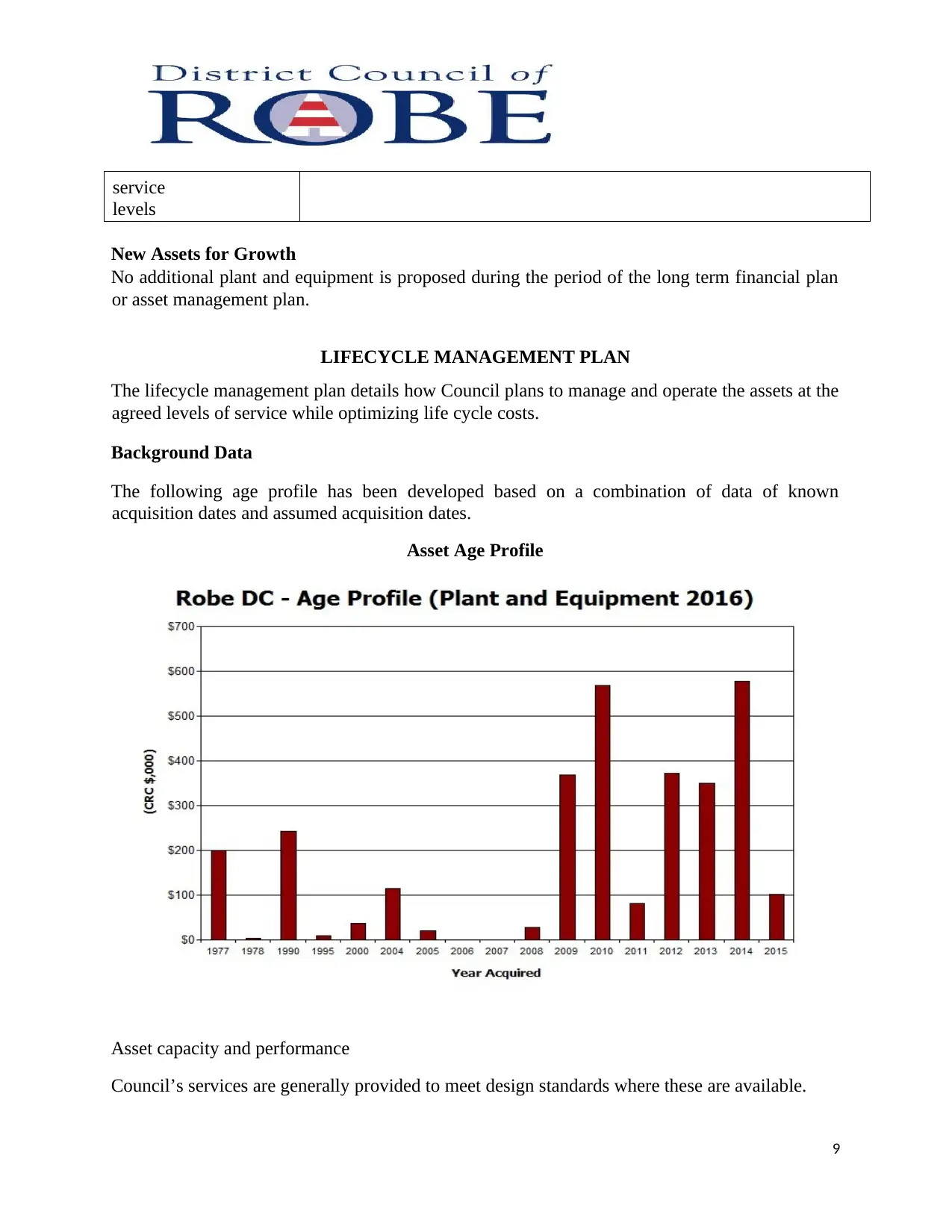
service
levels
New Assets for Growth
No additional plant and equipment is proposed during the period of the long term financial plan
or asset management plan.
LIFECYCLE MANAGEMENT PLAN
The lifecycle management plan details how Council plans to manage and operate the assets at the
agreed levels of service while optimizing life cycle costs.
Background Data
The following age profile has been developed based on a combination of data of known
acquisition dates and assumed acquisition dates.
Asset Age Profile
Asset capacity and performance
Council’s services are generally provided to meet design standards where these are available.
9
levels
New Assets for Growth
No additional plant and equipment is proposed during the period of the long term financial plan
or asset management plan.
LIFECYCLE MANAGEMENT PLAN
The lifecycle management plan details how Council plans to manage and operate the assets at the
agreed levels of service while optimizing life cycle costs.
Background Data
The following age profile has been developed based on a combination of data of known
acquisition dates and assumed acquisition dates.
Asset Age Profile
Asset capacity and performance
Council’s services are generally provided to meet design standards where these are available.
9
⊘ This is a preview!⊘
Do you want full access?
Subscribe today to unlock all pages.

Trusted by 1+ million students worldwide
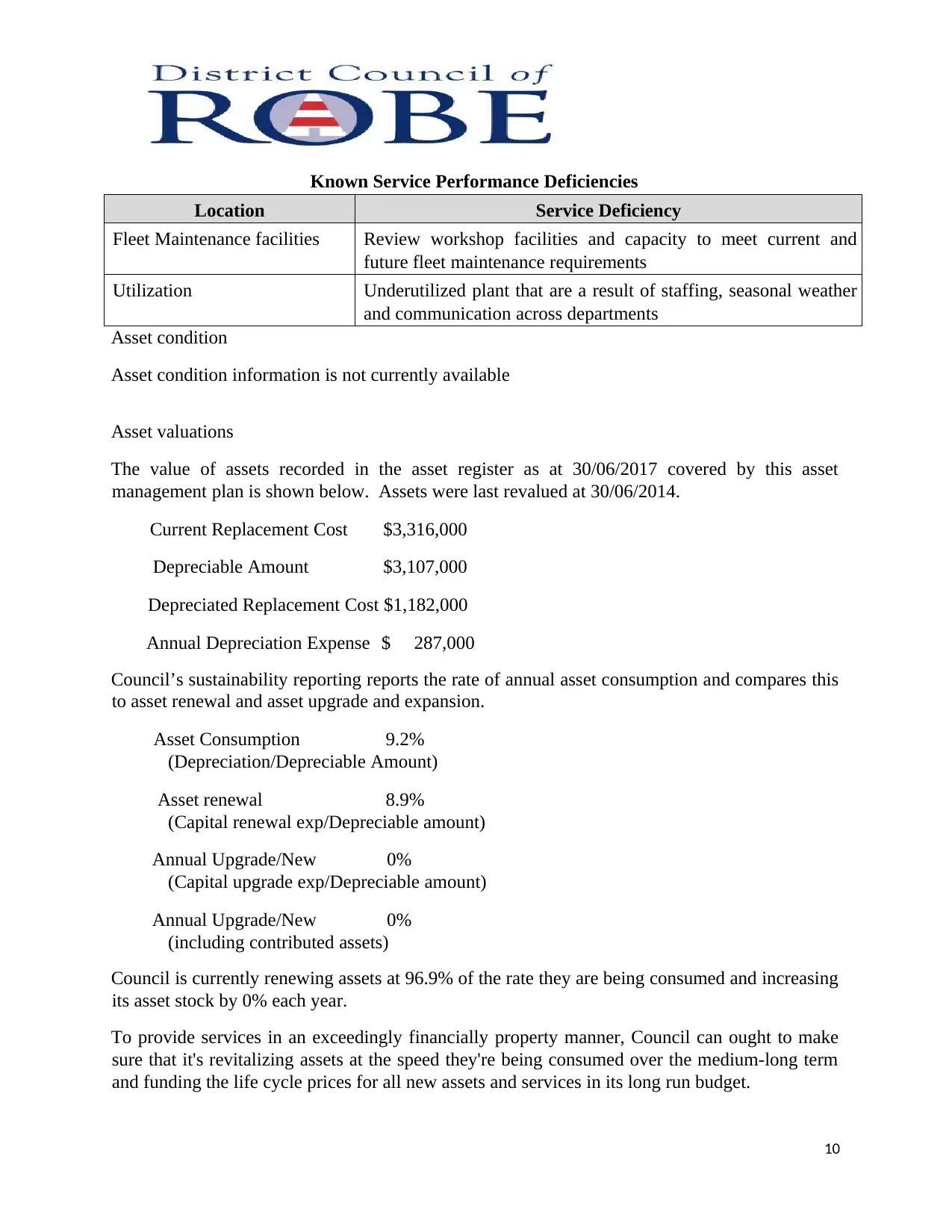
Known Service Performance Deficiencies
Location Service Deficiency
Fleet Maintenance facilities Review workshop facilities and capacity to meet current and
future fleet maintenance requirements
Utilization Underutilized plant that are a result of staffing, seasonal weather
and communication across departments
Asset condition
Asset condition information is not currently available
Asset valuations
The value of assets recorded in the asset register as at 30/06/2017 covered by this asset
management plan is shown below. Assets were last revalued at 30/06/2014.
Current Replacement Cost $3,316,000
Depreciable Amount $3,107,000
Depreciated Replacement Cost $1,182,000
Annual Depreciation Expense $ 287,000
Council’s sustainability reporting reports the rate of annual asset consumption and compares this
to asset renewal and asset upgrade and expansion.
Asset Consumption 9.2%
(Depreciation/Depreciable Amount)
Asset renewal 8.9%
(Capital renewal exp/Depreciable amount)
Annual Upgrade/New 0%
(Capital upgrade exp/Depreciable amount)
Annual Upgrade/New 0%
(including contributed assets)
Council is currently renewing assets at 96.9% of the rate they are being consumed and increasing
its asset stock by 0% each year.
To provide services in an exceedingly financially property manner, Council can ought to make
sure that it's revitalizing assets at the speed they're being consumed over the medium-long term
and funding the life cycle prices for all new assets and services in its long run budget.
10
Location Service Deficiency
Fleet Maintenance facilities Review workshop facilities and capacity to meet current and
future fleet maintenance requirements
Utilization Underutilized plant that are a result of staffing, seasonal weather
and communication across departments
Asset condition
Asset condition information is not currently available
Asset valuations
The value of assets recorded in the asset register as at 30/06/2017 covered by this asset
management plan is shown below. Assets were last revalued at 30/06/2014.
Current Replacement Cost $3,316,000
Depreciable Amount $3,107,000
Depreciated Replacement Cost $1,182,000
Annual Depreciation Expense $ 287,000
Council’s sustainability reporting reports the rate of annual asset consumption and compares this
to asset renewal and asset upgrade and expansion.
Asset Consumption 9.2%
(Depreciation/Depreciable Amount)
Asset renewal 8.9%
(Capital renewal exp/Depreciable amount)
Annual Upgrade/New 0%
(Capital upgrade exp/Depreciable amount)
Annual Upgrade/New 0%
(including contributed assets)
Council is currently renewing assets at 96.9% of the rate they are being consumed and increasing
its asset stock by 0% each year.
To provide services in an exceedingly financially property manner, Council can ought to make
sure that it's revitalizing assets at the speed they're being consumed over the medium-long term
and funding the life cycle prices for all new assets and services in its long run budget.
10
Paraphrase This Document
Need a fresh take? Get an instant paraphrase of this document with our AI Paraphraser
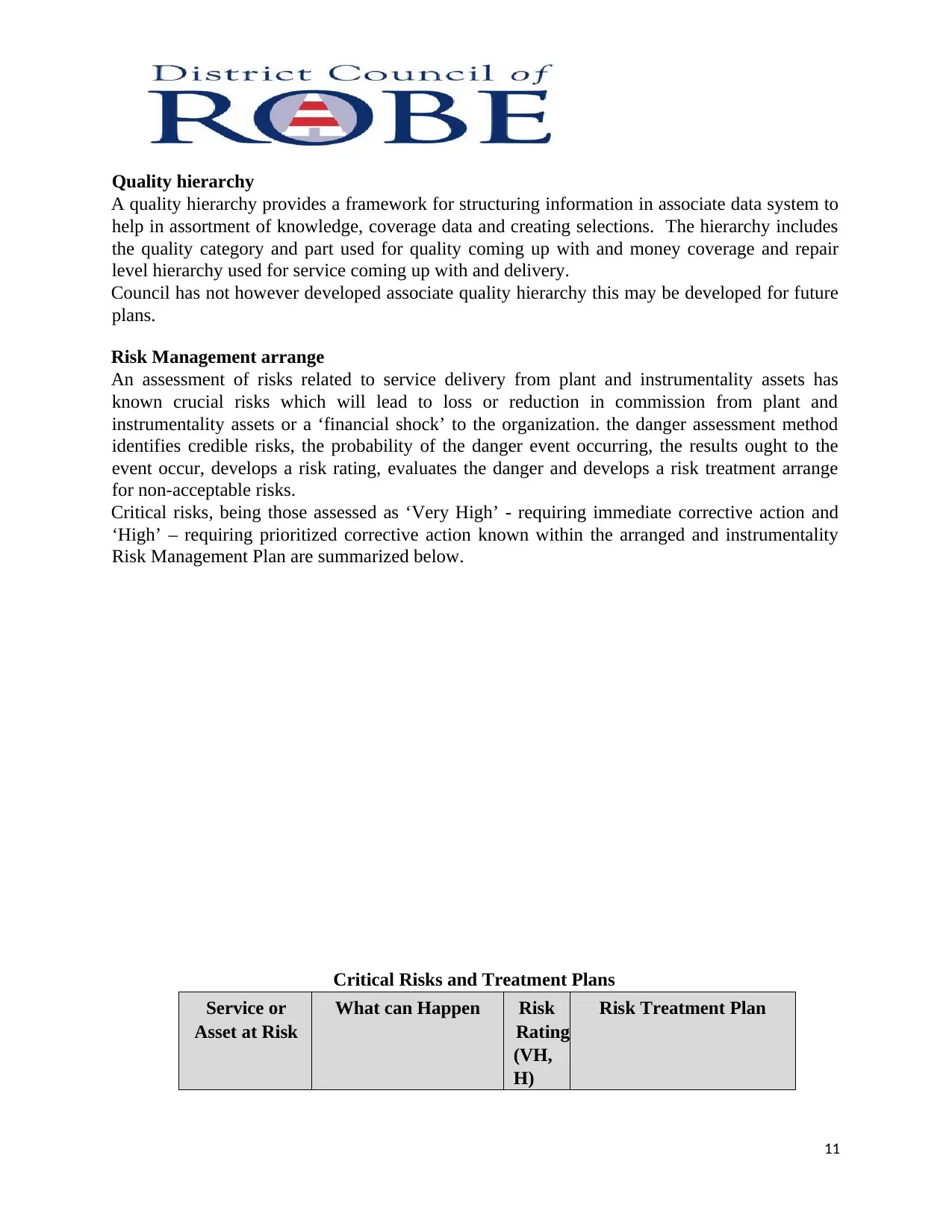
Quality hierarchy
A quality hierarchy provides a framework for structuring information in associate data system to
help in assortment of knowledge, coverage data and creating selections. The hierarchy includes
the quality category and part used for quality coming up with and money coverage and repair
level hierarchy used for service coming up with and delivery.
Council has not however developed associate quality hierarchy this may be developed for future
plans.
Risk Management arrange
An assessment of risks related to service delivery from plant and instrumentality assets has
known crucial risks which will lead to loss or reduction in commission from plant and
instrumentality assets or a ‘financial shock’ to the organization. the danger assessment method
identifies credible risks, the probability of the danger event occurring, the results ought to the
event occur, develops a risk rating, evaluates the danger and develops a risk treatment arrange
for non-acceptable risks.
Critical risks, being those assessed as ‘Very High’ - requiring immediate corrective action and
‘High’ – requiring prioritized corrective action known within the arranged and instrumentality
Risk Management Plan are summarized below.
Critical Risks and Treatment Plans
Service or
Asset at Risk
What can Happen Risk
Rating
(VH,
H)
Risk Treatment Plan
11
A quality hierarchy provides a framework for structuring information in associate data system to
help in assortment of knowledge, coverage data and creating selections. The hierarchy includes
the quality category and part used for quality coming up with and money coverage and repair
level hierarchy used for service coming up with and delivery.
Council has not however developed associate quality hierarchy this may be developed for future
plans.
Risk Management arrange
An assessment of risks related to service delivery from plant and instrumentality assets has
known crucial risks which will lead to loss or reduction in commission from plant and
instrumentality assets or a ‘financial shock’ to the organization. the danger assessment method
identifies credible risks, the probability of the danger event occurring, the results ought to the
event occur, develops a risk rating, evaluates the danger and develops a risk treatment arrange
for non-acceptable risks.
Critical risks, being those assessed as ‘Very High’ - requiring immediate corrective action and
‘High’ – requiring prioritized corrective action known within the arranged and instrumentality
Risk Management Plan are summarized below.
Critical Risks and Treatment Plans
Service or
Asset at Risk
What can Happen Risk
Rating
(VH,
H)
Risk Treatment Plan
11
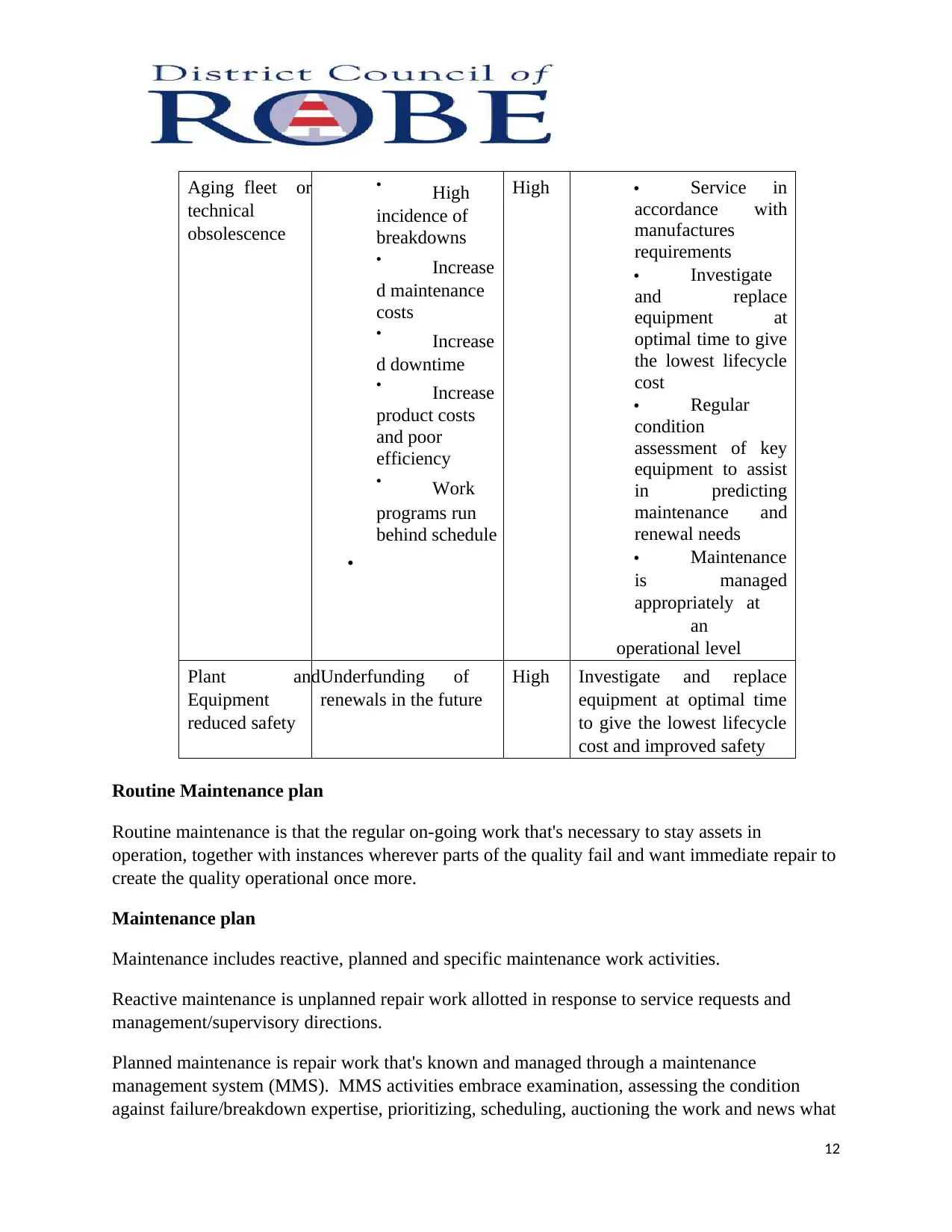
Aging fleet
technical
obsolescence
or • High
incidence of
breakdowns
• Increase
d maintenance
costs
• Increase
d downtime
• Increase
product costs
and poor
efficiency
• Work
programs run
behind schedule
•
High • Service in
accordance with
manufactures
requirements
• Investigate
and replace
equipment at
optimal time to give
the lowest lifecycle
cost
• Regular
condition
assessment of key
equipment to assist
in predicting
maintenance and
renewal needs
• Maintenance
is managed
appropriately at
an
operational level
Plant and
Equipment
reduced safety
Underfunding of
renewals in the future
High Investigate and replace
equipment at optimal time
to give the lowest lifecycle
cost and improved safety
Routine Maintenance plan
Routine maintenance is that the regular on-going work that's necessary to stay assets in
operation, together with instances wherever parts of the quality fail and want immediate repair to
create the quality operational once more.
Maintenance plan
Maintenance includes reactive, planned and specific maintenance work activities.
Reactive maintenance is unplanned repair work allotted in response to service requests and
management/supervisory directions.
Planned maintenance is repair work that's known and managed through a maintenance
management system (MMS). MMS activities embrace examination, assessing the condition
against failure/breakdown expertise, prioritizing, scheduling, auctioning the work and news what
12
technical
obsolescence
or • High
incidence of
breakdowns
• Increase
d maintenance
costs
• Increase
d downtime
• Increase
product costs
and poor
efficiency
• Work
programs run
behind schedule
•
High • Service in
accordance with
manufactures
requirements
• Investigate
and replace
equipment at
optimal time to give
the lowest lifecycle
cost
• Regular
condition
assessment of key
equipment to assist
in predicting
maintenance and
renewal needs
• Maintenance
is managed
appropriately at
an
operational level
Plant and
Equipment
reduced safety
Underfunding of
renewals in the future
High Investigate and replace
equipment at optimal time
to give the lowest lifecycle
cost and improved safety
Routine Maintenance plan
Routine maintenance is that the regular on-going work that's necessary to stay assets in
operation, together with instances wherever parts of the quality fail and want immediate repair to
create the quality operational once more.
Maintenance plan
Maintenance includes reactive, planned and specific maintenance work activities.
Reactive maintenance is unplanned repair work allotted in response to service requests and
management/supervisory directions.
Planned maintenance is repair work that's known and managed through a maintenance
management system (MMS). MMS activities embrace examination, assessing the condition
against failure/breakdown expertise, prioritizing, scheduling, auctioning the work and news what
12
⊘ This is a preview!⊘
Do you want full access?
Subscribe today to unlock all pages.

Trusted by 1+ million students worldwide
1 out of 26
Your All-in-One AI-Powered Toolkit for Academic Success.
+13062052269
info@desklib.com
Available 24*7 on WhatsApp / Email
![[object Object]](/_next/static/media/star-bottom.7253800d.svg)
Unlock your academic potential
Copyright © 2020–2025 A2Z Services. All Rights Reserved. Developed and managed by ZUCOL.